
13 minute read
Destinations: South East Turkey
South East Turkey’s Mesopotamian Allure
Text by JUHAN KAMARUDDIN Images by MUHAMMAD HASIF MOHD JELANI
Gaya Travel Magazine team recently travelled to the fascinating South Eastern Anatolian Region (South East Turkey). Travellers who have experienced visiting the more established North East and Western parts of Turkey should complement their experience by setting foot in this captivating up-and-coming region.

But why should travellers go all the way to South East Turkey, you might ask? To Gaya Travel Magazine team, the top two most compelling answers come in the form of the groundbreaking Gobeklitepe archaeological site and the wondrous Mount Nemrut, both enlisted as UNESCO World Heritage Sites. Your trip to South East Turkey must include these two gems, including the charming city of Sanliurfa. But take note: these are not the only attractions to be found in South East Turkey; the region is actually full of breathtaking sceneries, culture, heritage, food and shopping, thus should be on all travellers’ bucket list!
In South East Turkey, locals tend to behave more conservatively, yet no less welcoming. The region’s culture is not only Turkish but incorporates Kurdish and Arabic influences as well, making it distinctly Mesopotamian.
During summer, South East Turkey turns arid; this becomes more apparent as travellers get closer to the Upper Mesopotamian plains representing the northern part of the historically significant Fertile Crescent spanning from the Upper Egypt all the way to western fringes of modern-day Iran passing through Palestine, Lebanon, Syria, South East Turkey and Iraq. Due to its fecund soil, South East Turkey’s local economy runs on agriculture, mainly wheat cultivation. The region is also famous for producing juicy and refreshing watermelons.
Exploring South East Turkey region: Diyarbakir –Hasankeyf –Sanliurfa –Gobeklitepe –Mount Nemrut –Halfeti –Gaziantep
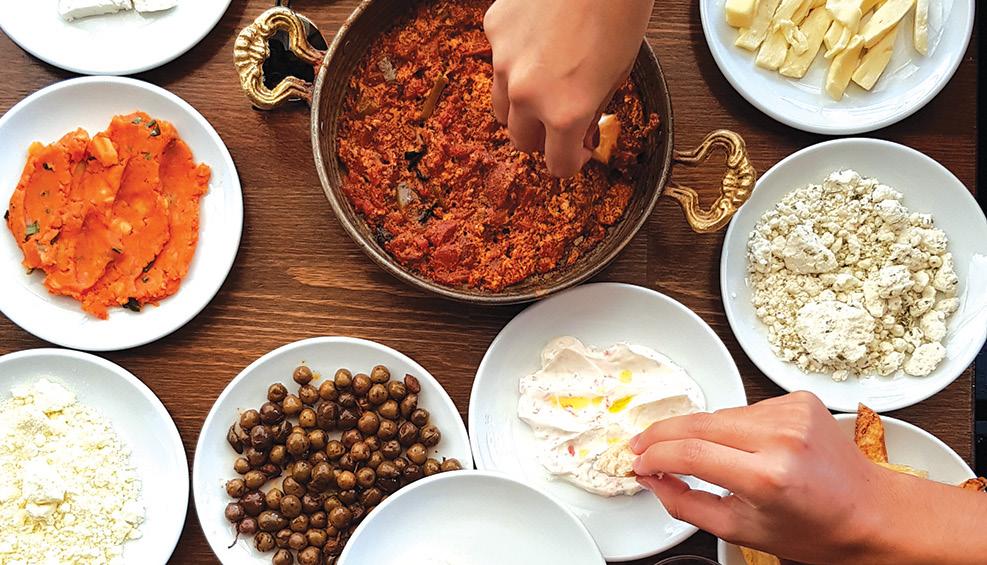
Enjoying meze breakfast spread at Hasan Pasha Hani in Diyarbakir.
One of the gateways to South East Turkey is Diyarbakir, part of the Sanliurfa sub-region. This city sits along the banks of Tigris (Dicle in Turkish or Dijlah in Arabic), one of the two great rivers (the other being Euphrates), which replenish the Mesopotamian plains. Interestingly, various heritage landmarks found in Diyarbakir such as the Prophet Solomon Mosque and Diyarbakir Great Mosque are made from basalt, rendering them dark grey or black, built in Seljuk architectural style, different from the Ottoman’s. Prophet Solomon Mosque is also important to Islamic history since this is the place where travellers can locate the tombs of Prophet Muhammad’s 27 companions. There are Roman vestiges too like the ramparts of the formerly six-kilometre long Walls of Diyarbakir and the Citadel in the city, denoting Diyarbakir’s cosmopolitan past.
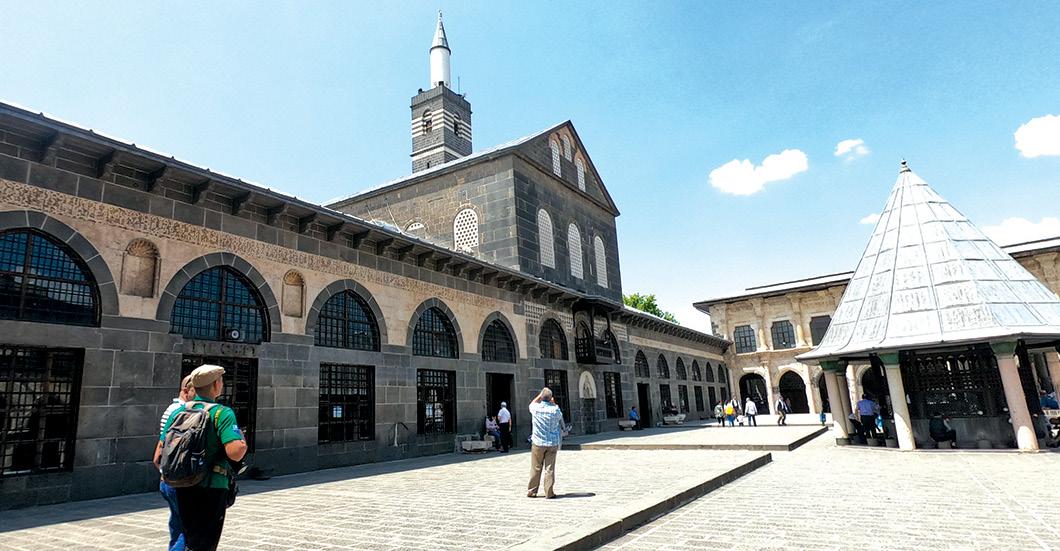
Diyarbakir Great Mosque.
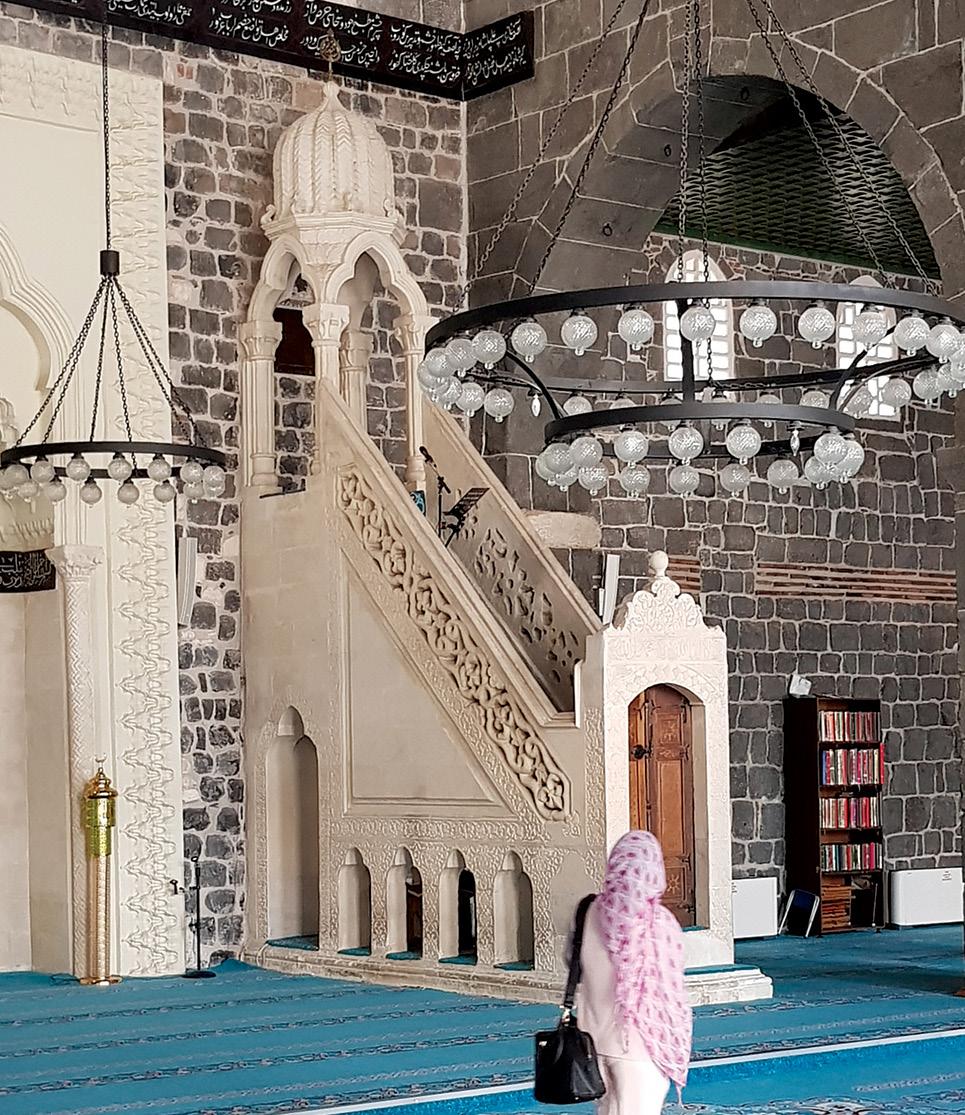
Inside Diyarbakir Great Mosque.
As you head to Sanliurfa, be sure to swing by Hasankeyf in Batman Province, an hour and a half ’s drive from Diyarbakir. Hasankeyf is a quaint settlement along the banks of Tigris River with history spanning over a millennium. It once stood at the first East and West crossroads and became one of the hubs for agriculture and scripture in Mesopotamia. Travellers can witness the sight of Hasankeyf directly from the opposite shore of the Tigris River and imagined how majestic the settlement would have been like during its heyday. From Hasankeyf, it takes another three hours and a half to arrive at Sanliurfa.

Balikligol or Halil ur Rahman pool.
The city of Urfa – now called Sanliurfa after the founder of Turkey Republic Kamal Ataturk declared it so to mean ‘Glorious Urfa’ – is renowned as the place where prophet Abraham – a major proponent of monotheism whose faith serves as the foundation for Judaism, Christianity and Islam – was thrown into the pyre by the evil King Nimrod for rejecting idol worship. As the story goes, the pyre miraculously cooled and transformed into a lake, while the pyre’s glowing embers turned into fishes. The lake, referred to as Balikligol or Halil ur Rahman pool, including the fishes, are considered sacred and popular among travellers. Balikligol sits at the foot of the imposing Sanliurfa Fortress, where travellers can climb up to enjoy the panorama of Sanliurfa city from a higher terrain. Sanliurfa is also the base for travellers to check out Gobeklitepe.
Another place to visit within Sanliurfa region: Old Halfeti

The half sunken minaret of an old village mosque in Halfeti.
The old Halfeti village – around an hour and a half ’s drive from Sanliurfa – is a settlement inundated by a man-made lake due to the construction of Birecik Dam to supply water and hydroelectricity to the surrounding communities. Travellers are recommended to cruise around the lake to see Rumkale (Byzantine Fortress), built in 678 A.D.; caves inhabited by man since 3,000 B.C.; and traces of an old village now submerged, particularly the dramatic yet at the same time melancholic-looking half sunken minaret of an old mosque.
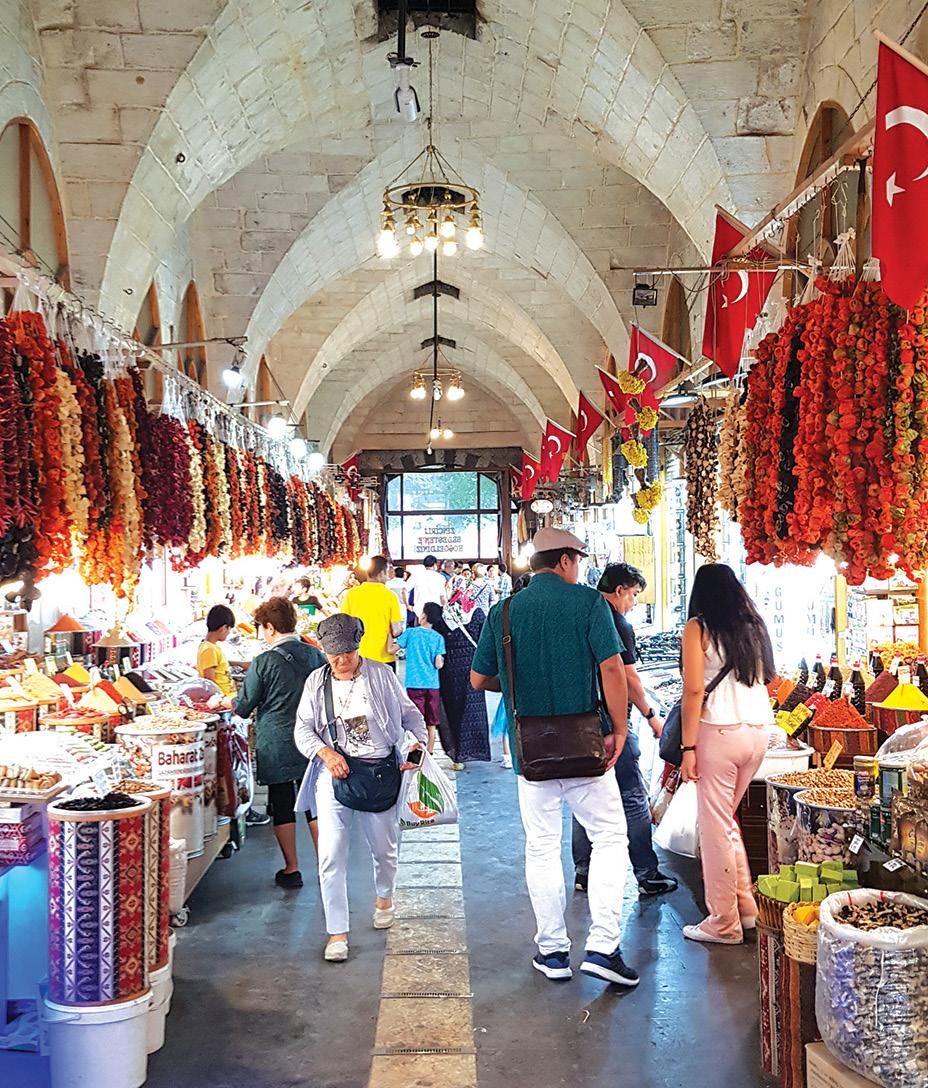
A bazaar in Gaziantep that mostly sells spices.
Travellers can choose to culminate their South East Turkey journey at Gaziantep, Turkey’s city of gastronomy, popular for dishes like lahmacun (delicious pizza topped with spicy meat and herbs) and baklava (Turkish pastry sweetened by sherbet, a light syrup made from sugar, water, and lemon juice). The city is also great for shopping because it has bazaars brimming with exotic goods like spices, hand-made soaps and handicrafts.
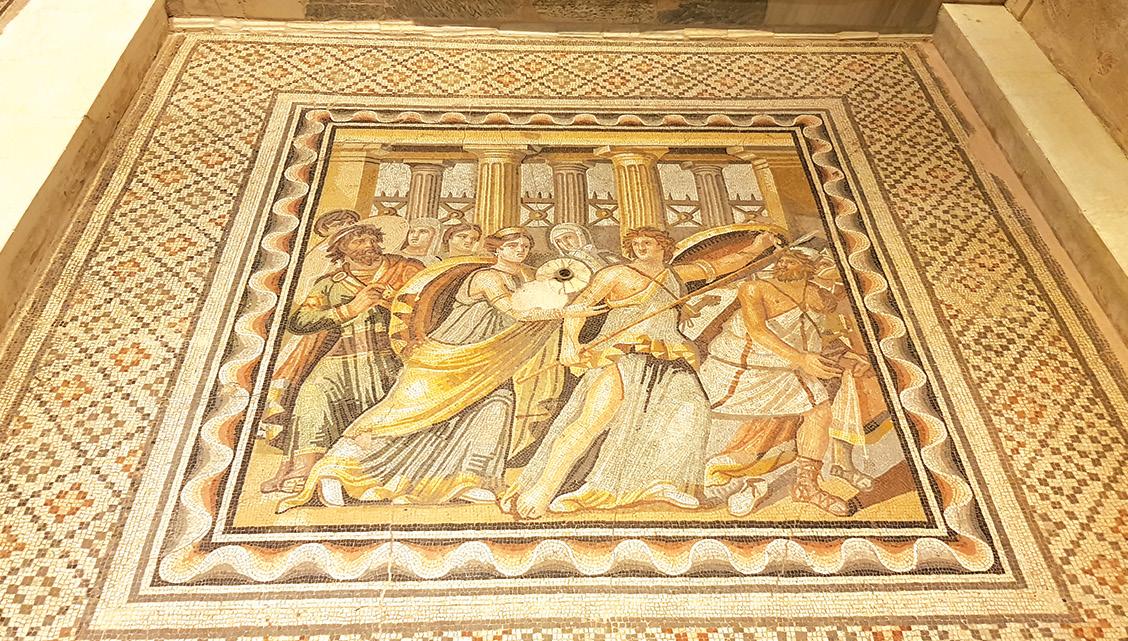
Beautiful mosaic design depicting ancient mythology displayed at Zeugma Mosaic Museum in Gaziantep.
Another attraction that travellers should never miss when being in Gaziantep is Zeugma Mosaic Museum (https://muze. gov.tr/muze-detay?SectionId=GZN01&DistId=GZN) to feast their eyes over inspiring ancient mosaic designs that are as old as 2,000 years, salvaged from the ruins of public baths and villas found around the area. During ancient times, Zeugma was home to many villas and public buildings embellished with elegant and timeless mosaic designs as a way for the citizens to flaunt their wealth, contributed by trade and commerce because Zeugma was strategically positioned along the old Silk Road connecting Antioch (modern-day Antakya in Turkey) to China. Lovers of art and design are sure to be in awe of these masterfully-crafted mosaic designs, notably the iconic Gypsy Girl, proof of the ancient local craftsmen’s outstanding workmanship and sense of aesthetics.
Where to enjoy good food in South East Turkey

Baklava at Imam Cagdas in Gaziantep, claimed to be the best in the world.
• Diyarbakir - Savour the beguiling and lavish spread meze comprising delicious home-made small dishes alongside locally baked bread for breakfast at Kahvalti Evi & Café (+90 412 228 0818), housed within a remarkably wellpreserved Ottoman caravanserai first built in 1547 called Hasan Pasha Hani, now filled with contemporary eateries and shops. • Batman – Have a satisfying local lunch at Comce Aile Et Lokantasi (+90 488 213 1776). • Urfa – Have dinner amidst upscale setting while enjoying traditional musical performance at Cevahir Han (http://www.cevahirhan.com/). • Gaziantep – Salivate over the best baklava in the world at Imam Cagdas (https://www.imamcagdas.com/). • Eski Halfeti – Have local fish for lunch on one of the floating restaurants tethered along the shores of the manmade lake created by Birecik Dam, submerging the old Halfeti village.
Absorbing the surrounding landscapes of Mount Nemrut
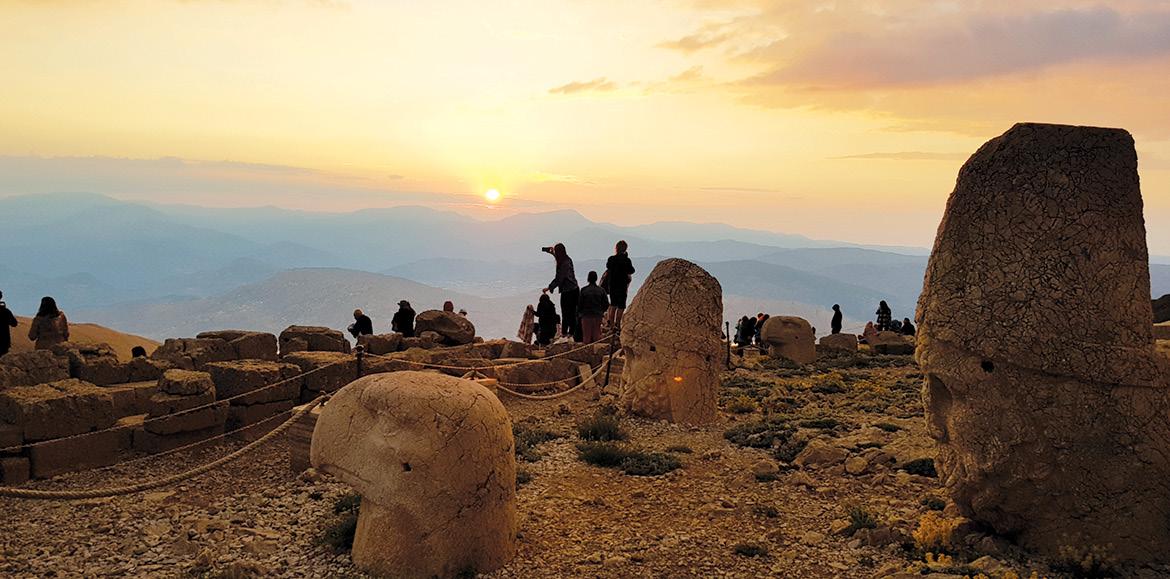
Capturing sunset from the Western Terrace of Mount Nemrut.
Situated 85 kilometres from the city of Adiyaman, 180 kilometres from Sanliurfa, 240 kilometres from Gaziantep, and 2,134 metres above sea-level, Mount Nemrut (http:// mtnemrut.com/) is the tomb of Antiochus 1, the halfArmenian (father was of Persian descent), half-Greek (mother was Macedonian) king who ruled from 70 B.C. until 38 B.C. over the kingdom of Kommagene, a swathe of land ensconced between the Seleucid (Eastern) and Roman (Western) empires, today covering northern Gaziantep and Adiyaman. Antiochus I’s tomb reflects the convergence of Eastern and Western cultures resulting from his mixed parentage and Kommagene’s unique geopolitical position.
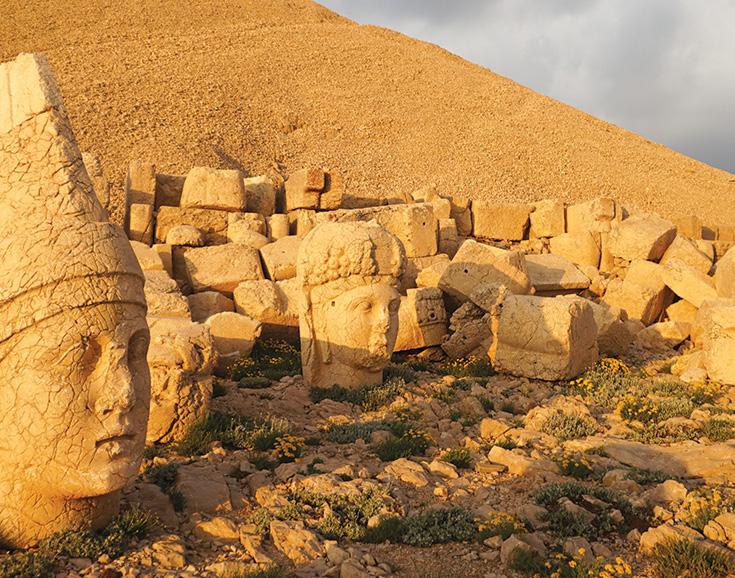
The Western Terrace bathed in gold light as the sun sets.
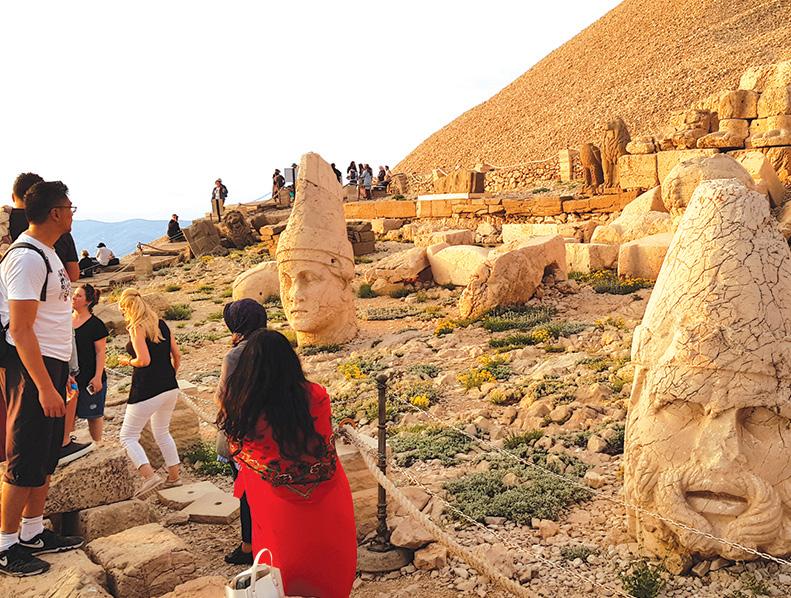
Visitors admiring the sculptures on the The Western Terrace of Mount Nemrut.
Gaya Travel Magazine rates Mount Nemrut as one of Turkey’s most photogenic UNESCO World Heritage Site due to the presence of the amazing larger-than-life sculptures and statues that infuse Persian, Hellenistic and Anatolian styles. These sculptures, comprising deities and mythical characters, are grouped into two terraces facing different directions: the sculptures representing characters with Persian names are placed on the Eastern Terrace facing sunrise, while characters with Greco-Roman names, including certain Persian deities, are on the Western terrace facing sunset. With its East-West orientation, Mount Nemrut is one of the best places in Turkey for travellers to catch sunrise or sunset from the respective terraces.
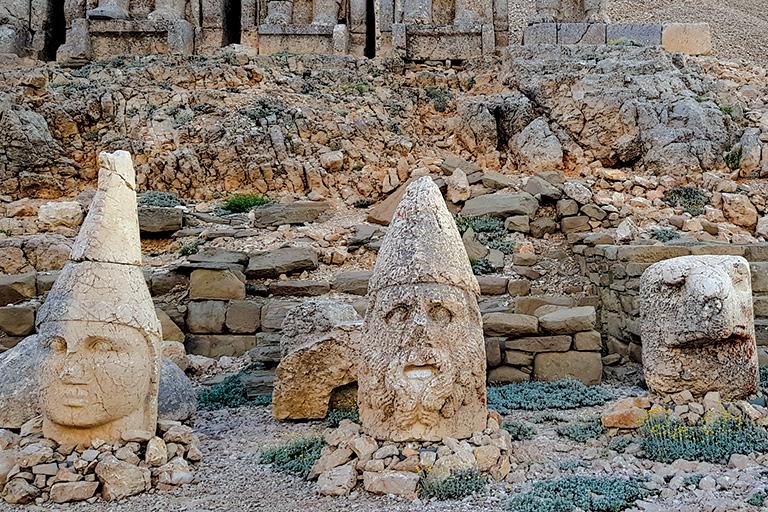
The Eastern Terrace of Mount Nemrut.
Other places to visit near Mount Nemrut:
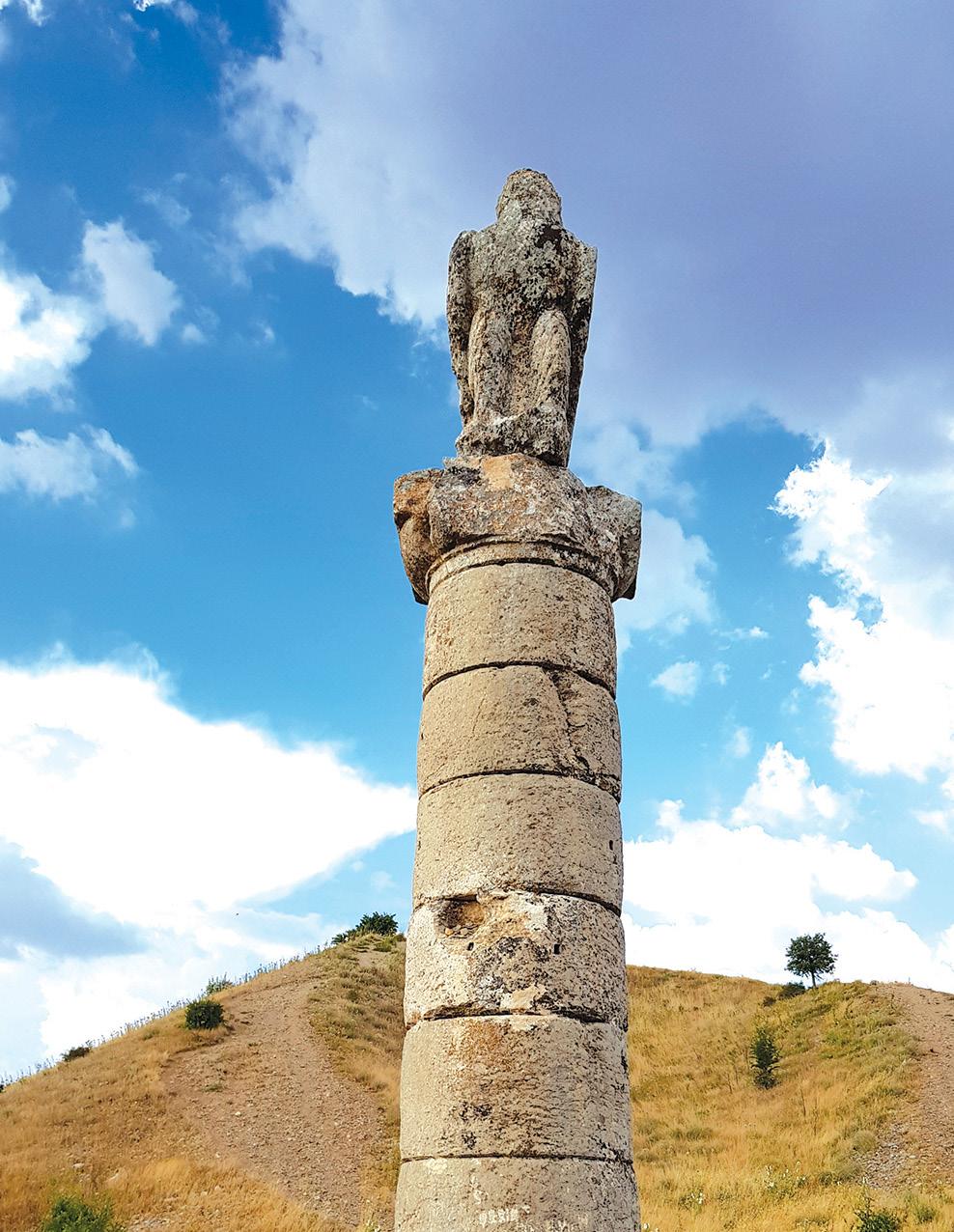
The column with sculpture of a bird that gives the mound its moniker, Karakush Tumulus.
• Karakush Tumulus – A burial mound where Kommagene royal family were laid to rest, this site is marked by a column with a sculpture of karakush (‘black bird’) at the southern side. Three other columns found here are topped by a lion, a bull and relief of King Mithridates II (the one who ordered the creation of the mound) shaking hands with his sister Laodike. The mound is known to contain the remains of King Mithridates II’s mother, sister and niece.
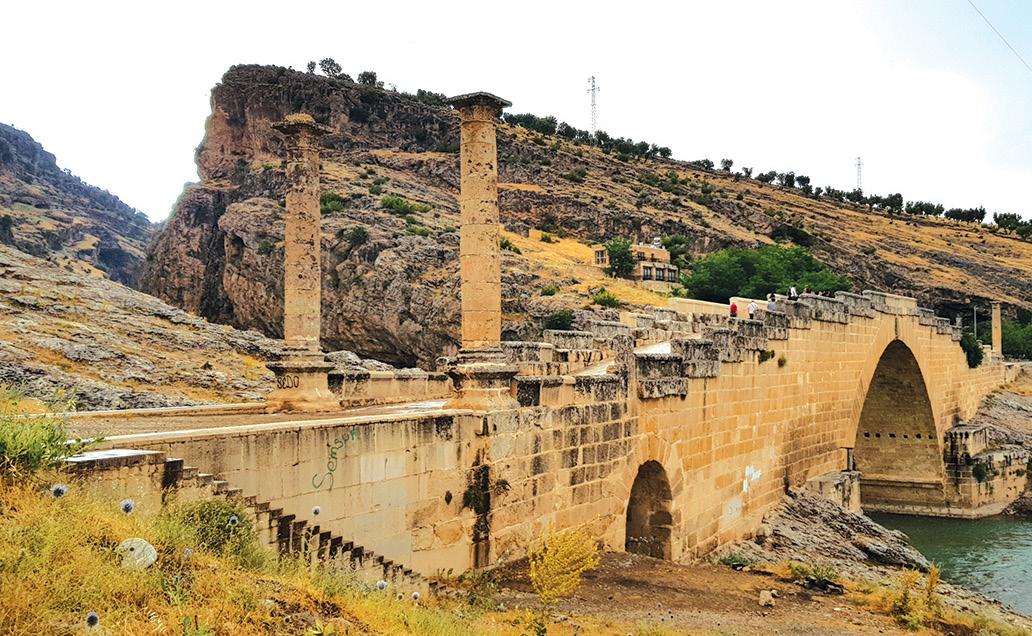
Severan Bridge.
• Severan Bridge (Cenderan Bridge) – Built in 198 A.D. by four Kommagenean cities in honour of the Roman Emperor Lucius Septimius Severus, this is the second largest Roman arch bridge still in existence. The bridge and its natural surroundings offer a lovely setting for travellers to take in and take selfies.
Following the footsteps of the ancients at Gobeklitepe

Excavations are still ongoing at Gobeklitepe.
Discovered in 1963 and enlisted as a UNESCO World Heritage Site in 2018, Gobeklitepe (https://www.sanliurfa. bel.tr/icerik/226/30/gobeklitepe) is a ground-breaking archaeological site believed to be a temple for funerary ritual and place of gathering during the Neolithic period, confirmed to be as old as 12,000 B.C. to 9,000 B.C., making it the oldest temple in the world, approximately 7,000 years older than the Egyptian pyramids and Stonehenge! Even the wheel and writing were not yet invented during the time when the site was built, indicating humans’ capacity to achieve impressive engineering feats way earlier than what was thought before.

Travellers can conveniently view the excavated parts of Gobeklitepe from the platforms surrounding the site.
Before the discovery of Gobeklitepe, located around 12 kilometres from the centre of Sanliurfa, it was once thought that between 12,000 B.C. and 9,000 B.C., during the era called Mesolithic, humans still lived in caves and constantly moved from one place to another. It was then followed by Neolithic, the era when humans started to settle down, begin farming and domesticate animals like dog, cattle, sheep, goat, and pig. The discovery of Gobeklitepe challenged the previous Neolithic timeframe because there are now evidences to show that humans had already been erecting large structures, living in permanent settlements, cultivating crops, domesticating animals, and developing organised society as far back as 14,000 years ago.

Ancient detailing on the limestone pillars that can be seen at Gobeklitepe.
The structures of Gobeklitepe were created entirely based on human effort and power through the use of rudimentary tools made from stone – neither metal tools nor animals were involved in constructing the site as this was way before the Bronze and Iron Ages. No other site as old as Gobeklitepe could rival or even match its decorative richness, attesting to Gobeklitepe builders’ prowess.
The core of the site is the main temple, where travellers can clearly observe the unearthed large T-shaped pillars representing humans and limestone slabs with carvings of animals, among them bull (believed to represent robustness and brawn); fox (cunningness); snake (symbolising healing since snakes were used for treatments during Neolithic times, as well as leadership because traces of snakes were found winding the heads of important individuals like leaders, chieftains or shamans) and crane (resembling selflessness and service to others – monks during Neolithic times covered themselves with crane feathers and replicated the movements of the crane during rituals, and the community who built the Gobeklitepe temple mimicked animal movements when praying). Huge amount of animal remains was also found around the site, confirming the area’s verdant past.
The site’s significance increased over time as more ancient people from communities living within the 200-kilometre radius from the site arrived at the area to worship, exchange goods and find marriage partners, enhancing Gobeklitepe’s role as the centre for ritual, social and economic functions. Those who arrived at Gobeklitepe eventually realised it was more efficient to settle down close to the site and grow crops rather than moving from place to place to hunt and gather food.

The replica of Gobeklitepe main temple within Sanliurfa Museum offers deeper insight.
To learn more about the impact that Gobeklitepe has on history, Sanliurfa Museum (http://mezopotamya.travel/index. php/en/sayfa/sanliurfa-muzesi), with its valuable artefacts and exhibits, explains how life at Gobeklitepe was like and how its story fits into the entire narrative of human civilisation. Travellers can even walk around the exact replica of the main temple of Gobeklitepe to personally have the sense of the structure’s actual scale and feel, deepening travellers’ appreciation towards Gobeklitepe even more. A stone’s throw away stands the 6,000-metre squared Haleplibahce Mosaic Museum where travellers can admire beautiful mosaic designs – specifically the depictions of Amazon queens hunting and Orpheus – found on site of what used to be the grounds of a Roman villa dating as far back as 4 B.C. to 3 B.C
Another place to visit near Gobeklitepe: Harran
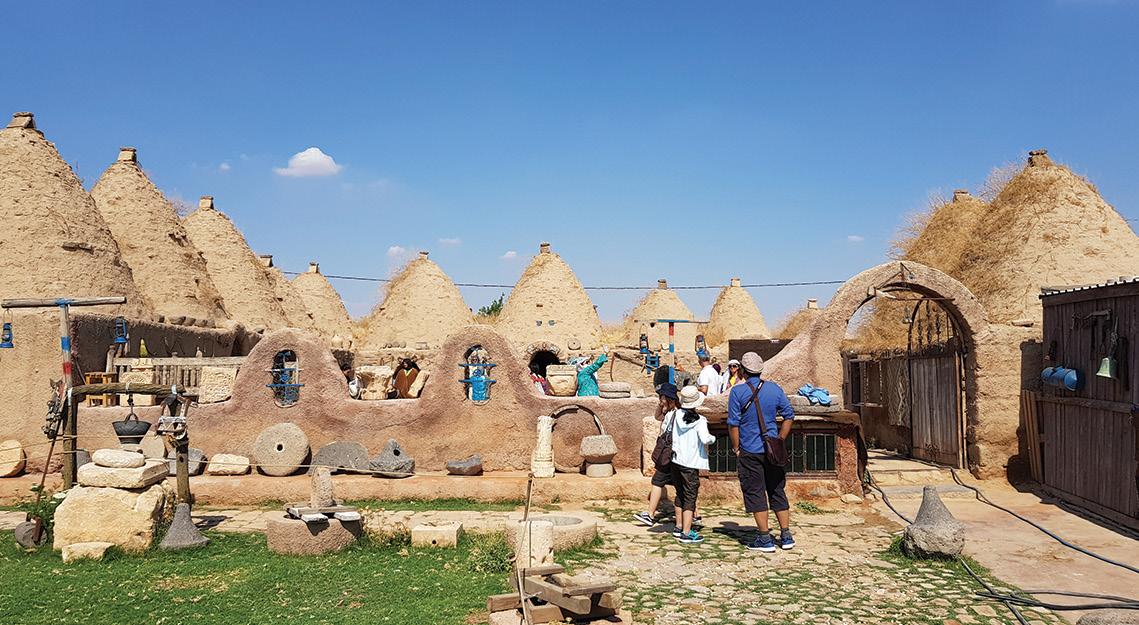
Harran conical houses.
Located 44 kilometres from Sanliurfa, Harran is the place mentioned in the Bible where prophet Abraham and his family stayed for a few years while journeying to Canaan from Ur. Now just a village, Harran was once a commercial hub straddling on a crossroad of major ancient trading routes. Travellers can explore the ruins of Harran university (claimed to be world’s first Islamic university and the principal centre for translating the classical works from Greek to Syriac and Arabic). Travellers can then proceed to the conical beehive-shaped mud-brick houses nearby, which provide natural thermal comfort to the houses’ inhabitants because the houses’ domed-roofs allow hot air to efficiently circulate upwards, away from the floor – the houses’ building technique had been used in the region for 3,000 years.
The best way to get to Turkey, especially South East Turkey, is to fly on Turkish Airlines (https://www.turkishairlines.com).
For more information on South East Turkey and Turkey, browse https://hometurkey.com/en, http://turkeytourism.com. my/, and https://www.goturkeytourism.com/destinations-turkey/ southeastern-anatolia-region-of-turkey.html.
Gaya Travel Magazine team members express our heartfelt gratitude to Turkish Embassy Tourism & Information Office, Kuala Lumpur, Malaysia and Turkish Airlines for making our trip to South East Turkey possible.










